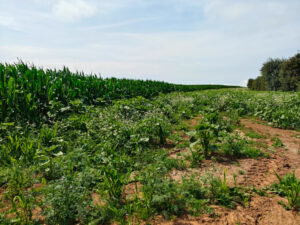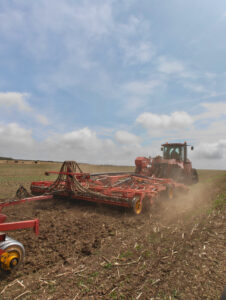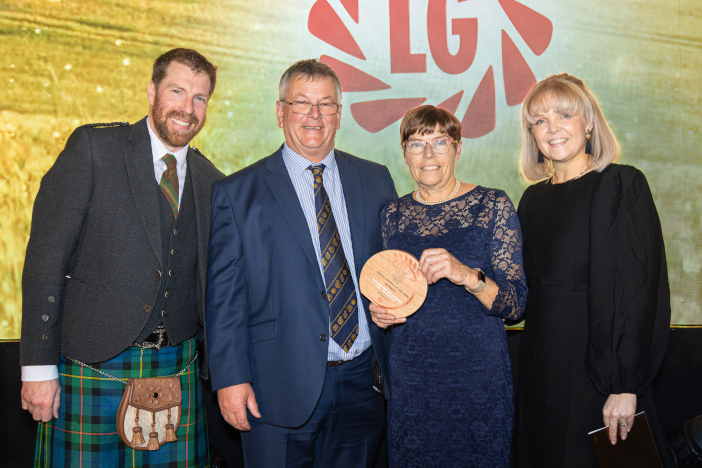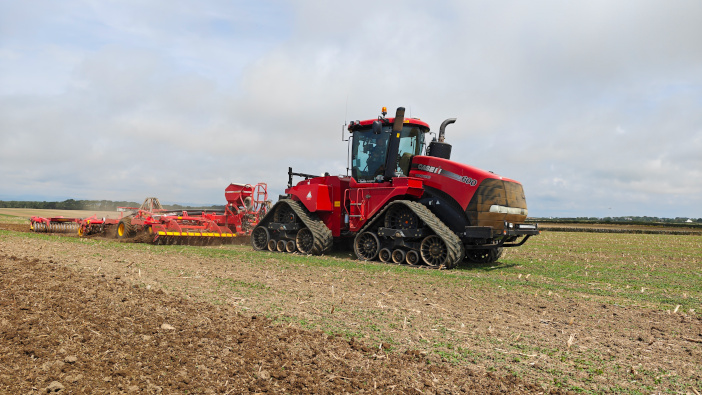R & L Anthony, run by Richard and Lyn Anthony, became two-time winners at the 2025 National Arable and Grassland Awards, adding Cereal Grower of the Year to their Oilseed Grower and Grower of the Year awards from 2024.
“It’s definitely something that has opened doors for us,” Richard explains. “We travelled out to New Zealand at the start of the year and were amazed at how many people had heard of us. They were as interested in what we are doing as we were in their farming systems.”
He adds that the awards have had a positive effect among the team, both on the farm and within R & L Contracting – a separate business run by their son David. “They’re a young team with a lot of enthusiasm and you can see that they are proud to be part of a successful, recognised business.”
The trip to New Zealand was eye-opening in different ways as well, with the Anthonys seeing how farming without subsidies could be possible. With the announcement of the Sustainable Farming Scheme (SFS) in Wales, which is due to start at the beginning of 2026, it has made them reassess how they will approach the offers within it.
“We want to farm sustainably, and we will do the conservation work required off us, but everything we implement has to have a net benefit for the farm as well,” Lyn explains. “Our focus can’t be on just be on the environmental benefits; it has to be on producing the most profitable crops we can.”
To maximise yields, Richard and Lyn focus on soil health. Utilising a long rotation and incorporating cover crops of phacelia, linseed and buckwheat, which act as bird cover and boost beneficials, while also improving soil structure and moisture retention – something that has been important this year.
 “Because we’re in a coastal area, the ground hasn’t been baked in the same way it has in more central parts of the UK,” Richard says. “However, we’ve had the same low rainfall, and our ground seems to have retained enough of that moisture to keep our yields high, as well as get newly sown crops established.”
“Because we’re in a coastal area, the ground hasn’t been baked in the same way it has in more central parts of the UK,” Richard says. “However, we’ve had the same low rainfall, and our ground seems to have retained enough of that moisture to keep our yields high, as well as get newly sown crops established.”
While their award this year was for cereal cropping, the oilseed crops have continued to impress. Richard puts this down to using the right varieties, sown at a low seed rate with a companion crop. A good dose of digestate and a few splashes of rain at the right time and the oilseed rape came good this year.
NPZ’s Vegas variety did particularly well, with Richard calling it outstanding. Staying abreast of the latest varieties is key, both say, and the farm takes part in multiple crop trials each year, with thousands of plots allocated.
“It works for both the plant breeders and us,” Lyn says. “They get regional data, in some occasionally difficult conditions, and we get an idea of the forthcoming options that will work well on our farm.”
For oilseed rape, this means finding varieties resistant to pod shatter, with good standing power to cope with exposed fields and vigour to outcompete cabbage stem flea beetle pressure.
Getting the wheat in
While we were there, the Anthonys still had a lot of winter wheat to bring in, although by the time you read this, it will probably be in the shed. Syngenta’s Graham had performed particularly well, they explain, though the variety never looks brilliant just before harvest. They’ve also got ground down with LG Typhoon, Palladium from KWS and Fitzroy with Secobra.
“The wheat is especially important this year, not least because straw prices are likely to be high,” Richard says. Straw will be shipped off-farm across South Wales to those looking to bed and feed animals.
The slightly cooler coastal location has also meant that forage crops have fared better for the Anthonys, with a crop of second-cut hay being sent to Yorkshire and the predicted third cut being made for haylage and sent off for processing.
“It’s another benefit of being open and networking with other growers,” adds Lyn. “It provides an opportunity to create new income streams without changing how we operate.”
Working with David and the contracting business, the farm will offer a bagged total mixed ration to suit youngstock and dry cows, which can be shipped across the South West to growers struggling to meet their forage needs.
The other main crop for the farm is maize, some of which is being trialled with an undersown companion mix including rye and vetch. The dry conditions had hampered establishment a little here, but as the maize canopy closed, there were signs that the ground cover was coming through.
“We were looking for ways to get the crop in effectively, without hammering the ground,” says Richard. “We fabricated a mixer box that fed seed directly into the slurry tanker and placed the seed with the digestate.”
He adds that they had conducted trials prior to building the unit to ensure that seeds would germinate in digestate without issues, and were so far happy with the results. “The cover will help us run over the ground when it comes to harvest, and means we’ll have a living root continuously between maize and our next crop.”

Expanding the farm
While much of what the Anthonys have done in the 12 months between their NAGA wins has been a continuation of the work previously, there has also been a significant expansion in area. At the end of 2024, they were offered an additional 170ha, bringing the total area up to 1,420ha.
They explain that the ground needed a lot of work. In a similar story to other parts of their tenanted ground, it was very stony, and they quickly put the stone collector to work, pulling enough stone out of the ground to put in hardstanding tracks around each field, with more to spare.
For the first year, they managed to get crops of oilseed rape and wheat in, with the rest put down as cover to start building organic matter in the thin, brashy soils. The ground also came with a yard and farm buildings, which are currently undergoing renovation for grain storage in the future.
“There’s a lot of potential there, but it will take time to come fully into our rotation,” Lyn says. “We’ll also be looking at restoring the hedgerows and establishing cover strips to boost the number of beneficials around the farm.”
The increase in hectarage has also come with machinery investments, with two of the New Holland T7.270s being swapped out for 340hp New Holland machines, shod on large diameter 900 very high flexion tyres. These will work alongside two additional 270s and a 260, with the Case IH Quadtrac still on farm for the most intensive cultivation work.
“We’re probably a little overpowered now,” says Richard. “But because the bulk of our nutrient applications are done with digestate, it’s key to get those timings right. Having the additional power means that we can get over ground quickly.”

They’ve also invested in fast inflation valves for each of the tractors and are considering a central tyre inflation system for the mainline drilling tractor. “I take tyre pressures very seriously, because they’re key to getting the best performance with the least possible soil damage,” he adds. “By minimising the time, it takes to adjust pressures, we can be sure that the right changes are made.”
Other major investments include a new MacDon FD2 Draper header for the New Holland combine, which Richard says has paid dividends already, with the deeper belt and improved feeding leading to significantly lower losses in the oilseed rape crops this year.
They’ve also upgraded their precision farming systems, utilising New Holland’s IntelliSense technology, which not only enables access to variable rate and section control, but also monitors where machines are in the field. “This will really help when we’re applying digestate, either with the tanker or an umbilical system, because operators will be able to see exactly where they ran out or where the other machine has worked.”
Combining nature and cropping
Plans for the future are focused on finding innovative ways to implement SFS requirements in ways that benefit the farm overall. In addition to the wildflower margins already in place, Richard and Lyn are looking at bridging strips that will use bird mixes and cover crops to create pathways for wildlife and beneficials through the fields.
The planning of this includes using yield maps to identify areas of fields which do not perform as well as the rest of the ground and using these first. The pair hope that they can work with neighbouring farms to join these strips, providing a net benefit for both the farms, the soil and wildlife in the area.
“If we can find the right seed mixes – plants that will benefit the soil, sequester nutrients and encourage beneficials – then it should meet all of these requirements while also enabling us to access funding through the SFS,” Lyn concludes.



